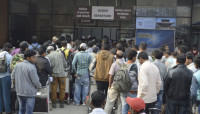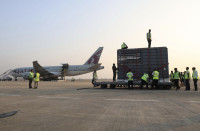Opinion
All in the heart
Dr Kumud Dhital’s successful transplantation of a dead heart must spur development in Nepal’s health and research sectors
Dr Mukesh Kumar Sah
Fifty-seven-year-old Michelle Gribilas and 40-year-old Jan Damen, both from Sydney, were among the first patients to receive the transplantation of a dead heart. This transplant procedure was performed by Dr Kumud Dhital, a Nepali doctor working as an associate professor at the St Vincent Hospital and as a researcher at Victor Chang Heart Institute in Sydney, Australia. Both operations performed by Dr Dhital were successful and both dead heart recipients recovered extremely well.
This is a great achievement by a Nepali doctor in Australia and it is matter of pride for Nepal and Nepalis. This is the world’s first major procedure for hearts donated after circulatory death (DCD). Those hearts were subsequently resuscitated and then successfully transplanted into patients with end-stage heart disease. The Sydney-based Victor Chang Cardiac Research Institute and St Vincent’s Hospital, who have jointly developed a special preservative solution that, together with the use of a machine, houses, resuscitates, and transports donor hearts till the operation can be performed. Researchers at these centres have named the technique ‘Heart-in-a-Box’. Researchers have indicated that the successful transplant of a dead heart could lead to a paradigm shift among donors, increasing the pool of donor organs.
Resuscitating a dead heart
The procedure became successful only after four long years of research on how to keep a dead heart beating and alive even after taking it out of the donor. The transplant team, headed by Prof Peter MacDonald, head of St Vincent’s heart transplant unit, developed a preservative and machine that helps in resuscitating the dead hea rt and keeps it beating for four-six hours. Until now, only beating hearts from brain-dead donors could be transplanted, limiting the number of donors for transplantation. Now, this new method will increase donors because it is possible to donate a heart even after it stops beating and can be successfully transplanted into end-stage heart disease patients who needs a heart transplant.
Due to the limitation of donors of beating hearts, only 2,000 hearts are transplanted every year. Transplanting the heart is not new but the development of an oxygen and nutrient-rich chemical that prevents the dead heart from deterioration and a machine that resuscitates the dead heart and provides a heart-friendly temperature and keeps it alive for four-six hour is really a milestone in the medical field. This time interval makes it easy for a surgeon as no donor will be available if the heart is planned for transplant with the donor and recipient in adjacent operating theatres, as performed in the 1960s when DCD hearts were utilised for the first time for transplantation. This technique also reduces ischemia that is supposed to develop during the chilling procedure done previously in beating heart transplants from brain dead patient.
The main significance of this milestone is that there will be a pool of donors, in comparison to beating heart donors, which is limited. That will of course increase the number of heart transplants in end-stage heart disease patients.
Learning from Dr Dhital
This breakthrough was welcomed across the world and especially in Nepal. This milestone by a Nepali doctor in Australia has also produced a wave in Nepal. Most social networks were filled with comments and opinions regarding Dr Dhital’s great achievement. It is thought that the heart-in-a-box can save up to 30 percent more lives by increasing the number of available organs. So we must count the hard work of Dr Dhital in the field of research outside the country.
I hope that Dr Dhital’s achievement will be appreciated not just through words and notes but by developing Nepal’s health sector and developing research activity in our country, where health personnel can utilise their skills and knowledge for something similarly new in the near future. It would be shameful if the concerned government authority does not learn from Dr Dhital’s achievement.
But this is really a product of team work and the credit must go to all members of Prof MacDonald’s team, but especially to Dr Dhital who performed the very first successful transplantation of a heart that had stopped beating. Big congratulations to all the team members of this heroic deed.
Sah is a Medical Officer at the BP Koirala Institute of Health Sciences, Dharan ([email protected])




 9.12°C Kathmandu
9.12°C Kathmandu









%20(1).jpg&w=300&height=200)

